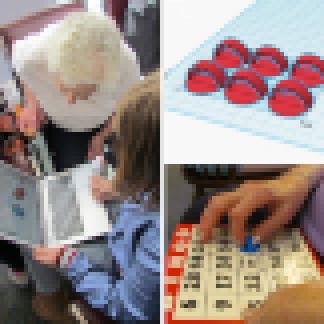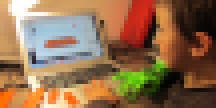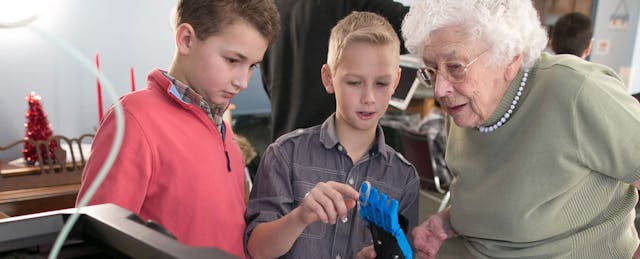Rich Lehrer knew that 3D printers could do more than spit out keychains and Yoda heads. In 2013, he led a group of eighth graders at the Brookwood School in Manchester-by-the-Sea, Massachusetts that designed and printed a prosthetic hand for Lehrer’s then 3-year-old son, Max.
But it was a suggestion from a colleague that unleashed the full potential of 3D printing and Making as a way to teach middle school students design thinking skills—as well as empathy and collaboration.
The idea? Have the students work with senior citizens to identify real world problems that could be addressed by designing and prototyping solutions.
Encourage collaboration and diverse perspectives
As with many provocative answers, this one started with an insightful question.
While planning a 3D design pilot with Lehrer, Brookwood sixth-grade science teacher Annie Johnson asked, “Why don’t we look for places outside of our school where we could get groups to submit problems to be solved through a design process?” So Johnson reached out to Harborlight House, an affordable senior-living facility in the nearby town of Beverly.
As part of Brookwood School’s annual Steep Week of short, intensive courses, half-a-dozen sixth graders enrolled in Lehrer and Johnson’s D-Zign Girlz class. The students went to Harborlight and met with five seniors, who shared their life stories. The girls, in turn, showed the seniors how a 3D printer works and explained how they used a free, browser-based design tool called Tinkercad to create objects.
Then they put their heads together, identifying problems the seniors faced and brainstorming possible solutions.
The Brookwood students used Play-Doh, cardboard, and duct tape to create prototypes of their proposed devices, before producing 3D-printed objects. The surprising collaboration led to some ingenious outcomes: a playing-card holder for someone with a bad rotator cuff; a bingo marker that is easy to pick up and move; a bagel holder that makes slicing safer.
The D-Zign Girlz program could just as easily have been called D-Zign Seniorz. “One thing that was crucial to the success of this was the diversity of thought,” Lehrer says. “We had young designers with very little life experience working with seniors, who had lots of life experience but maybe not much technical expertise.”

Teach kids to iterate
Last fall, Lehrer and Johnson rolled out D-Zign Kidz, getting the entire sixth grade involved in a yearlong design collaboration with local seniors.
Through his earlier work, Lehrer had realized that the key to kids creating effective solutions with 3D design and printing “is to go multiple times through the iterative cycle.” He adds, “but 3D printing is not well set up for that—a single print can take up to 20 hours.”
To save time, plastic, and electricity, Lehrer and Johnson created an approach called “design slicing”—printing roughly 5 to 10 percent of the entire object, enough to check measurements and utility. The slices make it possible to go through many iterations of each invention and make it easier for the students to respond creatively to feedback on early versions.
“3D printing is this incredible wedge that you can use to show kids that it’s possible for sixth graders to develop unique, 100 percent personal inventions that work,” Lehrer says.
Put students in the driver's seat
Lehrer himself did not have much technical expertise when he started down this path four years ago. For most of his career, he has been a middle school science teacher—in Canada, Venezuela, and Brazil, before landing at Brookwood. “I wasn’t winning any large-scale awards for my job of teaching the periodic table,” he says.
A summer fellowship in Rwanda sent Lehrer looking for middle school STEM projects that would link students to the community. He stumbled on a YouTube video that showed how to make a prosthetic hand using 3D printing. The possibilities resonated with Lehrer, whose son, Max, had been born in 2010 with symbrachydactyly, a condition that prevented the growth of fingers on his right hand.
After arriving at Brookwood, Lehrer recruited 12 eighth-graders to spend the year trying to build Max a workable prosthetic; it hardly appeared that Lehrer was on the cusp of a revolution. By his own admission, he knew almost nothing about 3D printing. Which was probably OK—because Brookwood didn’t have a 3D printer.
His students divided into three teams—one to find a 3D printer, “whatever that was,” Lehrer adds; one to find thermoplastic; and one to find the screws and other hardware the project required. Each of the three groups persevered and succeeded. After his students finished their third version of the Robohand, Lehrer brought in Max.
“We had him try it out,” Lehrer says, “and he was able to pick up some blocks. Our students were watching that and, oh god, I’m getting choked up talking about it,” remembers Lehrer.
“In 20 seconds, my whole professional and personal life pivoted,” he adds. “When Max used a device created by my students to do something he had never done before, that was a huge transformative moment. The Robohand was the beginning of the really interesting, exciting stuff.”
As he went deeper into digital fabrication, Lehrer saw the absolute necessity of having students design their own solutions rather than simply implement existing ones. Using a 3D printer to reproduce the work of others was a bit like using a car only as shelter from the rain. Lehrer wanted to put students in the driver's seat, give them the keys, and see where they would go.

Real learning needs real problems
To do that, Lehrer devised a way to put student designers in touch with people who need 3D designed solutions. He created the Problem Bank—an online repository for real-life problems posted by members of the school community. It gives design students the opportunity to develop real solutions to real problems, to feel empowered, and to have profound learning experiences. Problem Bank submissions include:
“When we draw self-portraits in art class, we need a support to keep the mirror in the same place for the duration of the drawing.”
“The plastic brackets that currently hold our library shelves tend to break easily when supporting large heavy books. Can you design new brackets?”
He even created guidelines for educators wanting to set up problem banks at their own schools. His tips? Teach empathy, grow problem finders, educate your community, and mobilize student leaders—among others.
For his efforts, Lehrer won a 2017 Infy Maker Award, was recently name a PBS Digital Innovator. So what comes next?

For Lehrer and his Brookwood students, what’s next involves developing specialized attachments for a base prosthesis he has designed; it would allow users to snap in, say, a drumstick, violin bow, or lacrosse stick.
Lehrer believes every school and, by extension, every individual should have a focused design challenge. “Wouldn’t it be cool,” he asks, “if every single person out there was empowered to solve their particular problem and was able to extrapolate from that and collaborate with people and solve other problems?
“It would be a pretty exciting world where you have seven billion people who all have first-hand knowledge of what it means to solve a problem in a constructive, effective, tangible way.”
Resources for Teaching Design Thinking and 3D Printing
The following resources include videos about Rich Lehrer's 3D design work with students, his own blog posts about teaching and learning, and information about his primary design tools.
| Video: Max | Lehrer describes how his students use 3D design and engineering skills to create prosthetics for children. |
| Video: 3D Printed Hand | The PBS Design Squad 3D prints a refined Robohand for Max. |
| Video: Problem Bank | Lehrer explains how 3D design and printing can bring generations together to solve community issues. |
| Blog post: So You're a Teacher with a 3D Printer - Now What? | Make Magazine |
| Blog post: Empathy: The Surprising Secret Sauce for Authentic STEM Project Design | Buck Institute for Education |
| Blog post: The Authenticity Spark | Ultimaker |
| Software: Tinkercad | An easy, browser-based 3D design and modeling tool; free for teachers and students |
| Software: Fusion 360 | A CAD modeling tool with advanced features and functionality; free for teachers and students |



